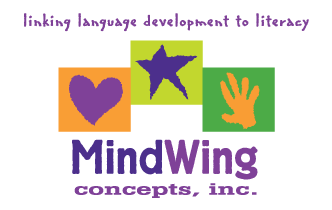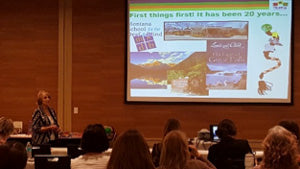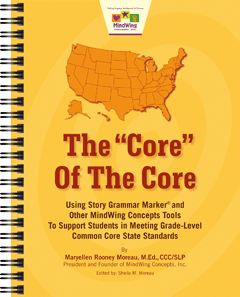Secure Checkout. FREE SHIPPING for Continental U.S. Orders over $60.
Menu
-
- Home
-
About Us
-
The Approach
-
Linking Language & Literacy
-
Professional Learning
-
Learning Resources
-
SHOP
-
Blog
-
- About MindWing
- Our People
- Contact Us
- Your Account
- Login
-
United States (USD $)

Secure Checkout. FREE SHIPPING for Continental U.S. Orders over $60.

Mondays with Maryellen
October 21, 2015
 Hi Everyone! I’m sorry this post is a couple of days late – “Mondays with Maryellen” is on Wednesday this week ☺. We just returned from a whirlwind series of workshops in both San Antonio, Texas and Billings, Montana. We had great audiences, fabulous times with colleagues, and of course the San Antonio RiverWalk, the Alamo and the Big Sky Sunsets were marvelous to visit. Sheila’s 20-month-old daughter Casey and our friend Mary accompanied us on this trip — we’ve included some photos!
Hi Everyone! I’m sorry this post is a couple of days late – “Mondays with Maryellen” is on Wednesday this week ☺. We just returned from a whirlwind series of workshops in both San Antonio, Texas and Billings, Montana. We had great audiences, fabulous times with colleagues, and of course the San Antonio RiverWalk, the Alamo and the Big Sky Sunsets were marvelous to visit. Sheila’s 20-month-old daughter Casey and our friend Mary accompanied us on this trip — we’ve included some photos!
San Antonio was 95 degrees – wow! Billings was comfortable in the 70s. However, when we returned to Massachusetts, it was to a 19-degree morning! Alas, Fall, the prelude to snow in New England!
The trip to Billings and the return to the 19-degree morning prompt me to relate a new invitation we’ve received: A visit to Alaska upon the invitation of AKSHA—Alaska Speech Language and Hearing Association 2016 Convention next October...

Adobe Voice gives “Voice” to Narrative or Expository Language
October 13, 2015
 It’s Technology Tuesday, and this month we will cover a simple, free tool to practice combining visuals and oral narration to produce an engaging video! A main goal of using MindWing’s Story Grammar Marker® and ThemeMaker® tools is to provide structure for oral discourse. Narrative or expository maps provide a “plan” for the elements of discourse, along with key words to help students connect their thoughts when formulating a story or explanation. In this way, a culminating activity of using any language map can involve asking students to “connect the dots” in formulating a complete story or using expository language. Adobe Voice, a free, easy-to-use app, provides a fast and motivating way to do this!...
It’s Technology Tuesday, and this month we will cover a simple, free tool to practice combining visuals and oral narration to produce an engaging video! A main goal of using MindWing’s Story Grammar Marker® and ThemeMaker® tools is to provide structure for oral discourse. Narrative or expository maps provide a “plan” for the elements of discourse, along with key words to help students connect their thoughts when formulating a story or explanation. In this way, a culminating activity of using any language map can involve asking students to “connect the dots” in formulating a complete story or using expository language. Adobe Voice, a free, easy-to-use app, provides a fast and motivating way to do this!...

Expository “My Research” Cut–and-Fold Booklet
October 08, 2015
 The “Core” of The Core manual contains many hands-on materials for student use. One of my favorites is the Expository “My Research” Cut–and-Fold Booklet. I have used this in many settings and grade levels, including centers and with intervention groups. Instructions are included in the manual.
The “Core” of The Core manual contains many hands-on materials for student use. One of my favorites is the Expository “My Research” Cut–and-Fold Booklet. I have used this in many settings and grade levels, including centers and with intervention groups. Instructions are included in the manual.
Sea Turtles by Gail Gibbons is one book that works very well with this activity since it includes all expository text structures. As an added resource, Maryellen recently did a section of a webinar on the topic of sea turtles that you might be interested in viewing. (Click here to view Sea Turtles expository analysis excerpt.)...
Character and Setting Collages for End-of-Year and Summer School!!
June 16, 2015
A fun end-of-year activity or summer school activity is making a Character or Setting Collage! You can use old magazines to cut out “Characters.” They may be pictures of celebrities, political figures, community leaders, animals, cartoons or advertisements with people who remind you of characters from children’s literature. Collages can be done individually by using Maps from the Story Grammar Marker® Manual or Braidy the StoryBraid® manual (below) and pasting the magazine clippings right on to the Map...
Technology Tuesday: Vocabulary, Summer Programming, and Story Grammar Marker®!
June 09, 2015 2 Comments
 Some years ago as an SLP in the elementary school setting, I was informed by a colleague of Isabel Beck’s revolutionary approach to targeting vocabulary. In the book Bringing Words to Life: Robust Vocabulary Development, co-written with Margaret McKeown and Linda Kucan, the authors describe a methodology for building vocabulary revolving around key principles...
Some years ago as an SLP in the elementary school setting, I was informed by a colleague of Isabel Beck’s revolutionary approach to targeting vocabulary. In the book Bringing Words to Life: Robust Vocabulary Development, co-written with Margaret McKeown and Linda Kucan, the authors describe a methodology for building vocabulary revolving around key principles...
Looking at Expository Discourse Across the Grade Levels
May 28, 2015
In each of our summer studies posts, we have been looking at recent research articles that may inform your use of Mindwing’s narrative and expository tools as you ease into a new school year. This post will look at a study that examined the expository language of typically developing 5th-9th graders along with their performance on a language elicitation protocol. In this way, the article provided key information about assessment, but also has supportive points for the use of the language structures of ThemeMaker® both in assessment and intervention.
The Rules of the Game: Properties of a Database of Expository Language Samples (Heilmann and Malone, 2014) was written by two researchers working at the university and school district levels, respectively, in order to summarize their efforts at constructing a database to illuminate language skills for this older age group and serve as a clinical basis of comparison. The full article is available via ASHAWire (ASHA’s electronic publications portal) if you are a member.
